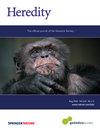Phylogeography of introgression: Spatial and temporal analyses identify two introgression events between brown and American black bears
IF 3.9
2区 生物学
Q2 ECOLOGY
引用次数: 0
Abstract
Brown bears (Ursus arctos) colonized North America from Eurasia in two distinct and temporally separated waves. Once in North America they encountered endemic American black bears (U. americanus) during range expansions from eastern Beringia southwards into the interior of the continent. The establishment of sympatry between these species provided the opportunity for hybridization and introgression, which was previously identified at the species level using D-statistics. Both species have broad spatial ranges that should limit the extent of introgression, such that it is found primarily between sympatric populations. Here, we used range-wide sampling and whole genome sequencing of both bear species to test for spatial variability in introgression. We identified two pulses of introgression between brown and American black bears, and demonstrate the introgressed segments occur across spatially structured lineages in both species. The first pulse occurred 270–120 kya, near the initiation of intraspecific divergence, approximately 99–93 kya, within each species. This pulse occurred as sympatry was established in western North America. The second pulse occurred between western American black bears and North American brown bears and lasted to 9 kya. Introgression was bidirectional and sympatric lineages had more introgressed tracts and a larger proportion of the genome introgressed from the other species. This study advances our phylogeographic understanding of both iconic bear species through investigating the timing of divergence and gene flow as bears expanded and contracted their ranges across North America.

进化演化的系统地理学:空间和时间分析确定了棕熊和美洲黑熊之间的两个进化演化事件。
棕熊分两波从欧亚大陆移居北美,这两波在时间上是分开的。有一次在北美,它们从东白令陆桥向南扩展到大陆内部时遇到了特有的美洲黑熊(美国黑熊)。这些物种之间的同域关系的建立为杂交和渐渗提供了机会,这是以前在物种水平上使用D-statistics识别的。这两个物种都有广阔的空间范围,这应该限制了渗透的程度,因此它主要是在同域种群之间发现的。在这里,我们使用大范围采样和全基因组测序来测试这两种熊的空间变异。我们确定了棕熊和美洲黑熊之间的两个渐渗脉冲,并证明渐渗片段发生在两个物种的空间结构谱系中。第一次脉冲发生在270-120 kya,接近种内分化的开始,大约99-93 kya,在每个物种内。这种脉动发生在北美西部共情区建立的时候。第二次脉冲发生在美国西部黑熊和北美棕熊之间,持续了9个月。基因渐渗是双向的,同域谱系有更多的基因渐渗束和更大比例的基因组渐渗来自其他物种。这项研究通过调查熊在北美扩张和收缩活动范围时的分化时间和基因流动,推进了我们对这两个标志性熊物种的系统地理学理解。
本文章由计算机程序翻译,如有差异,请以英文原文为准。
求助全文
约1分钟内获得全文
求助全文
来源期刊

Heredity
生物-进化生物学
CiteScore
7.50
自引率
2.60%
发文量
84
审稿时长
4-8 weeks
期刊介绍:
Heredity is the official journal of the Genetics Society. It covers a broad range of topics within the field of genetics and therefore papers must address conceptual or applied issues of interest to the journal''s wide readership
 求助内容:
求助内容: 应助结果提醒方式:
应助结果提醒方式:


